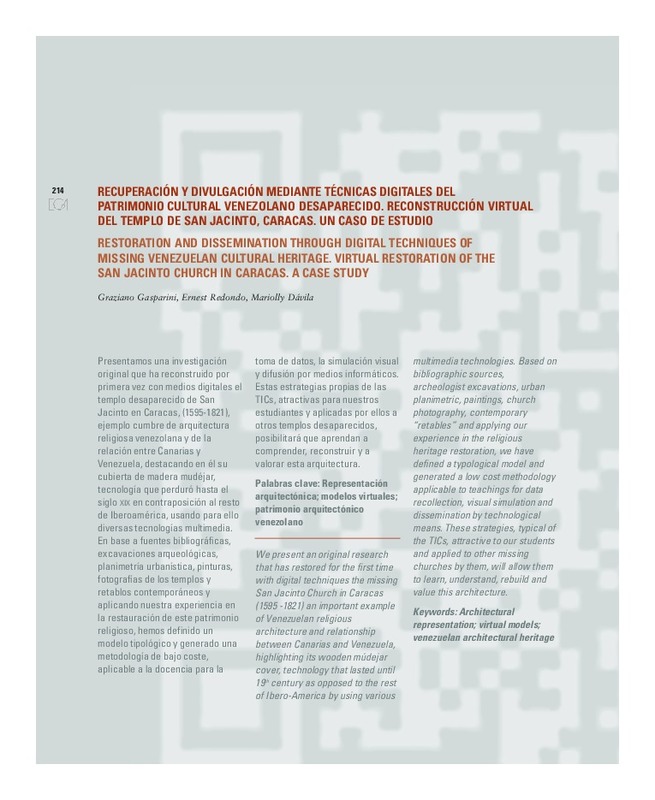JavaScript is disabled for your browser. Some features of this site may not work without it.
Buscar en RiuNet
Listar
Mi cuenta
Estadísticas
Ayuda RiuNet
Admin. UPV
RECUPERACIÓN Y DIVULGACIÓN MEDIANTE TÉCNICAS DIGITALES DEL PATRIMONIO CULTURAL VENEZOLANO DESAPARECIDO. RECONSTRUCCIÓN VIRTUAL DEL TEMPLO DE SAN JACINTO, CARACAS. UN CASO DE ESTUDIO
Mostrar el registro sencillo del ítem
Ficheros en el ítem
| dc.contributor.author | Gasparini, Graziano
|
es_ES |
| dc.contributor.author | Redondo, Ernest
|
es_ES |
| dc.contributor.author | Dávila, Mariolly
|
es_ES |
| dc.date.accessioned | 2013-03-01T11:00:13Z | |
| dc.date.available | 2013-10-23T22:30:53Z | |
| dc.date.issued | 2012 | |
| dc.identifier.issn | 1133-6137 | |
| dc.identifier.uri | http://hdl.handle.net/10251/27426 | |
| dc.description.abstract | [EN] We present an original research that has restored for the first time with digital techniques the missing San Jacinto Church in Caracas (1595 -1821) an important example of Venezuelan religious architecture and relationship between Canarias and Venezuela, highlighting its wooden múdejar cover, technology that lasted until 19th century as opposed to the rest of Ibero-America by using various multimedia technologies. Based on bibliographic sources, archeologist excavations, urban planimetric, paintings, church photography, contemporary ¿retables¿ and applying our experience in the religious heritage restoration, we have defined a typological model and generated a low cost methodology applicable to teachings for data recollection, visual simulation and dissemination by technological means. These strategies, typical of the TICs, attractive to our students and applied to other missing churches by them, will allow them to learn, understand, rebuild and value this architecture. | es_ES |
| dc.description.abstract | [ES] Presentamos una investigación original que ha reconstruido por primera vez con medios digitales el templo desaparecido de San Jacinto en Caracas, (1595-1821), ejemplo cumbre de arquitectura religiosa venezolana y de la relación entre Canarias y Venezuela, destacando en él su cubierta de madera mudéjar, tecnología que perduró hasta el siglo XIX en contraposición al resto de Iberoamérica, usando para ello diversas tecnologías multimedia. En base a fuentes bibliográficas, excavaciones arqueológicas, planimetría urbanística, pinturas, fotografías de los templos y retablos contemporáneos y aplicando nuestra experiencia en la restauración de este patrimonio religioso, hemos definido un modelo tipológico y generado una metodología de bajo coste, aplicable a la docencia para la toma de datos, la simulación visual y difusión por medios informáticos. Estas estrategias propias de las TICs, atractivas para nuestros estudiantes y aplicadas por ellos a otros templos desaparecidos, posibilitará que aprendan a comprender, reconstruir y a valorar esta arquitectura. | es_ES |
| dc.language | Español | es_ES |
| dc.language | Inglés | |
| dc.publisher | Editorial Universitat Politècnica de València | es_ES |
| dc.relation.ispartof | EGA. Revista de Expresión Gráfica Arquitectónica | |
| dc.rights | Reserva de todos los derechos | es_ES |
| dc.subject | Representación arquitectónica | es_ES |
| dc.subject | Modelos virtuales | es_ES |
| dc.subject | Patrimonio arquitectónico venezolano | es_ES |
| dc.subject | Architectural representation | es_ES |
| dc.subject | Virtual models | es_ES |
| dc.subject | Venezuelan architectural heritage | es_ES |
| dc.title | RECUPERACIÓN Y DIVULGACIÓN MEDIANTE TÉCNICAS DIGITALES DEL PATRIMONIO CULTURAL VENEZOLANO DESAPARECIDO. RECONSTRUCCIÓN VIRTUAL DEL TEMPLO DE SAN JACINTO, CARACAS. UN CASO DE ESTUDIO | es_ES |
| dc.title.alternative | RESTORATION AND DISSEMINATION THROUGH DIGITAL TECHNIQUES OF MISSING VENEZUELAN CULTURAL HERITAGE. VIRTUAL RESTORATION OF THE SAN JACINTO CHURCH IN CARACAS. A CASE STUDY | es_ES |
| dc.type | Artículo | es_ES |
| dc.date.updated | 2013-02-15T13:01:50Z | |
| dc.identifier.doi | 10.4995/ega.2012.1443 | |
| dc.rights.accessRights | Abierto | es_ES |
| dc.description.bibliographicCitation | Gasparini, G.; Redondo, E.; Dávila, M. (2012). RECUPERACIÓN Y DIVULGACIÓN MEDIANTE TÉCNICAS DIGITALES DEL PATRIMONIO CULTURAL VENEZOLANO DESAPARECIDO. RECONSTRUCCIÓN VIRTUAL DEL TEMPLO DE SAN JACINTO, CARACAS. UN CASO DE ESTUDIO. EGA. Revista de Expresión Gráfica Arquitectónica. 17(20):214-225. https://doi.org/10.4995/ega.2012.1443 | es_ES |
| dc.description.accrualMethod | SWORD | es_ES |
| dc.relation.publisherversion | https://doi.org/10.4995/ega.2012.1443 | es_ES |
| dc.description.upvformatpinicio | 214 | |
| dc.description.upvformatpfin | 225 | |
| dc.description.volume | 17 | |
| dc.description.issue | 20 | |
| dc.identifier.eissn | 2254-6103 | |
| dc.description.references | – BUENO, A. 1998, The Convent of San Jacinto: A multifaceted presence. 500 years of Evangelization, Dominicans in Venezuela (1498-1198), Proceedings of the International Congress of History. Merida - Caracas. | es_ES |
| dc.description.references | – GASPARINI, G. 2009, Listen to the Monument. Editorial Arte, Caracas, Venezuela. | es_ES |
| dc.description.references | – LIU, C.H. y LEE. C.F. 2009. The Design of a Mobile Navigation System Based on QR Codes for Historic Buildings, Proceedings CAADRIA (Yunlin, Taiwan). pp. 103-112. | es_ES |
| dc.description.references | – MARCO DORTA, E. 1967, Materials for the History of Culture in Venezuela (1523-1828), Madrid - Caracas. | es_ES |
| dc.description.references | – SARAVANI, S. y CAYTON, J. 2009 A conceptual model for the education deployement of QR codes. Proceedings ASCILITE, Auckland, pp. 919-922. | es_ES |








